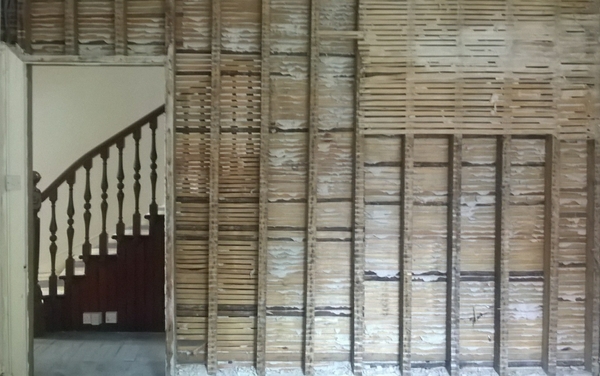Lath and plaster
Lath and plaster is a technique which was used to finish interior walls and ceilings from the early-18th until the early-to-mid-20th century. It was then generally superseded by drywall techniques and plasterboard.
The process involved laths (thin strips of timber) nailed to timber joists or posts and then covered with built-up layers of plaster. Laths typically measure 25 mm x 6 mm, and are positioned about 6 mm apart from each other to allow the plaster to penetrate into the gaps between them.
Typically three coats of plaster would then be applied:
- A ‘render’ layer about 6 mm thick to bond to and fill the gaps between the laths.
- A ‘floating’ layer about 6 mm thick to provide a relatively smooth surface for the third layer.
- A ‘setting’ layer about 3 mm thick to provide a completely smooth finish for decoration.
The first and second layers typically used a 1:3 lime putty to clean, sharp sand mixture. Animal hair was often added to assist with binding. The mixture for the third layer was usually a 3:1 lime putty to fine sand mixture or lime putty on its own.
As time went on, gypsum or cement was added which helped to reduce the setting time between layers.
The advantage of using lath was that it allowed for ornamental or decorative shapes, and could provide sound insulation and fire resistant properties.
However, it was a skilled craft and was a time-consuming activity and so was largely replaced by the use of pre-manufactured plasterboard towards the middle of the 20th century.
[edit] Related articles on Designing Buildings
Featured articles and news
The history of building regulations
A story of belated action in response to crisis.
Moisture, fire safety and emerging trends in living walls
How wet is your wall?
Current policy explained and newly published consultation by the UK and Welsh Governments.
British architecture 1919–39. Book review.
Conservation of listed prefabs in Moseley.
Energy industry calls for urgent reform.
Heritage staff wellbeing at work survey.
A five minute introduction.
50th Golden anniversary ECA Edmundson apprentice award
Showcasing the very best electrotechnical and engineering services for half a century.
Welsh government consults on HRBs and reg changes
Seeking feedback on a new regulatory regime and a broad range of issues.
CIOB Client Guide (2nd edition) March 2025
Free download covering statutory dutyholder roles under the Building Safety Act and much more.
AI and automation in 3D modelling and spatial design
Can almost half of design development tasks be automated?
Minister quizzed, as responsibility transfers to MHCLG and BSR publishes new building control guidance.
UK environmental regulations reform 2025
Amid wider new approaches to ensure regulators and regulation support growth.
The maintenance challenge of tenements.
BSRIA Statutory Compliance Inspection Checklist
BG80/2025 now significantly updated to include requirements related to important changes in legislation.























